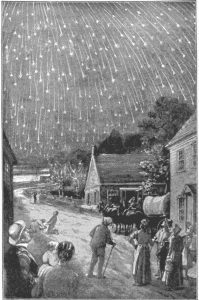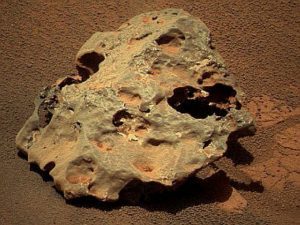“To see a shooting star means all sorts of good luck.”
The Pantagraph, July 10, 1897

Staying up late on a clear August night is an excellent way to create special summer memories at the Straits of Mackinac. With minimal light pollution and expansive vistas over two Great Lakes, the starry sky offers a spectacular show, free of charge, for all ages.
Each August, the Earth travels through a path of dust and debris left behind by the Swift-Tuttle Comet, resulting in the Perseid Meteor Shower. Astronomers name a meteor shower after the point from which it appears to emerge in the night sky, with this shower originating near the constellation Perseus. While “shooting stars” can be seen any night of the year, this event means more meteors than normal may be seen, as tiny bits of debris enter the atmosphere and streak across the sky. This year, the Perseids will display peak activity from August 11-14.
A great location to view the Perseid Meteor Shower is at the Headlands International Dark Sky Park, just three miles west of Mackinaw City. Open to the public 24 hours a day, year-round, the site received official designation as an International Dark Sky Park in 2011. Information about programs, events and activities can be found at www.midarkskypark.org.
Summer isn’t the only good season for stargazing at the Straits of Mackinac. Every November, the Leonid Meteor Shower occurs, offering the possibility of shooting stars at an earlier hour, during a much colder time of the year. This activity peaks about every 33 years, as the Earth passes through remnants left by the Tempel-Tuttle Comet. It’s safe to say that those who looked up night of November 13, 1833, never forgot the experience. Over the span of approximately nine hours, it was estimated that as many as 240,000 meteors fell, with those in eastern North America receiving the best views. The display was so intense that some witnesses reportedly feared Judgement Day was at hand.
The following year, the U.S. Secretary of War submitted a circular to military posts throughout the United States, requesting reports of the “unusual Meteoric Display” on November 13, 1834, in order to see if the event had been repeated. From Fort Mackinac, Captain John Clitz submitted he had “made inquiry of the sentinels who were on post on the night of the 13th of November last, and one only, an intelligent young man, who was posted at the north angle of the fort, saw a shower of meteors in the north, between twelve and 1 o’clock, the duration of which, as near as he can recollect, was about one hour.”

NASA/JPL/colorization by Stuart Atkinson
When a meteor survives a trip through the atmosphere and strikes the ground intact, it’s then defined as a meteorite. While the vast majority of meteors burn up entirely in Earth’s atmosphere, meteorites are more common on planetary bodies with little or no atmosphere. As NASA’s Opportunity Rover explored the surface of Mars in late 2009, scientists discovered several meteorites in close succession. Composed of iron and nickel, they named each find after an island back on Earth. “Block Island” was found in July 2009 and “Shelter Island” at the end of September. “Mackinac Island,” measuring about 30 centimeters across, was discovered October 13, 2009. Perhaps someday, interplanetary tourists will visit Mackinac on Mars!
In the meantime, you can sip a cup of cocoa and enjoy the night sky from the comfortable confines of earth. While viewing the Perseid Meteor Shower, you’re also invited to remember,
“To see a shooting star is an especially happy omen. It signifies that good things are in store for you. Fortune will soon be knocking at your door.”
Quad-City Times, August 27, 1896









